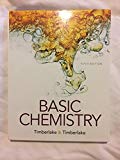
Concept explainers
(a)
Interpretation: An equality and two conversion factors for Person G’s serum iron level should be written.
Concept Introduction: In humans, the normal range for serum iron is 80 to 160 mcg/dL.The low value of iron from this standard value indicates the deficiency of iron that is cause of anaemia.
(a)
Answer to Problem 2.89FU
Equality must be: 42 mcg of iron = 1 dL of blood
Conversion factors are:
Explanation of Solution
During the doctor visit of Person G; he complained about feeling tired. The blood test showed the level of iron indicates 42 mcg/dL that is low compare to permissible value of iron blood. It indicates the iron deficiency in Person G that may cause anaemia.
Thus, the equality must be: 42 mcg of iron = 1 dL of blood
An arithmetical multiplier which is used for converting a quantity expressed in one unit into another equivalent set of units is said to be conversion factor.
So, the conversion factors are:
(b)
Interpretation: The micrograms of iron present in the 8.0 mL of sample of Person G’s blood should be calculated.
Concept Introduction:An arithmetical multiplier which is used for converting a quantity expressed in one unit into another equivalent set of units is said to be conversion factor.
(b)
Answer to Problem 2.89FU
3.4 mcg
Explanation of Solution
Given Information:
42 mcg of iron = 1 dL of blood
Calculation:
Thus, the iron level in Person G’s blood was found 42 mcg/dL hence in 8 mL; it will be 3.4 mcg.
Want to see more full solutions like this?
Chapter 2 Solutions
Basic Chemistry - Fifth Edition
 ChemistryChemistryISBN:9781305957404Author:Steven S. Zumdahl, Susan A. Zumdahl, Donald J. DeCostePublisher:Cengage Learning
ChemistryChemistryISBN:9781305957404Author:Steven S. Zumdahl, Susan A. Zumdahl, Donald J. DeCostePublisher:Cengage Learning ChemistryChemistryISBN:9781259911156Author:Raymond Chang Dr., Jason Overby ProfessorPublisher:McGraw-Hill Education
ChemistryChemistryISBN:9781259911156Author:Raymond Chang Dr., Jason Overby ProfessorPublisher:McGraw-Hill Education Principles of Instrumental AnalysisChemistryISBN:9781305577213Author:Douglas A. Skoog, F. James Holler, Stanley R. CrouchPublisher:Cengage Learning
Principles of Instrumental AnalysisChemistryISBN:9781305577213Author:Douglas A. Skoog, F. James Holler, Stanley R. CrouchPublisher:Cengage Learning Organic ChemistryChemistryISBN:9780078021558Author:Janice Gorzynski Smith Dr.Publisher:McGraw-Hill Education
Organic ChemistryChemistryISBN:9780078021558Author:Janice Gorzynski Smith Dr.Publisher:McGraw-Hill Education Chemistry: Principles and ReactionsChemistryISBN:9781305079373Author:William L. Masterton, Cecile N. HurleyPublisher:Cengage Learning
Chemistry: Principles and ReactionsChemistryISBN:9781305079373Author:William L. Masterton, Cecile N. HurleyPublisher:Cengage Learning Elementary Principles of Chemical Processes, Bind...ChemistryISBN:9781118431221Author:Richard M. Felder, Ronald W. Rousseau, Lisa G. BullardPublisher:WILEY
Elementary Principles of Chemical Processes, Bind...ChemistryISBN:9781118431221Author:Richard M. Felder, Ronald W. Rousseau, Lisa G. BullardPublisher:WILEY





